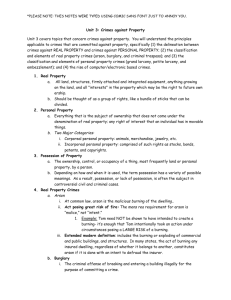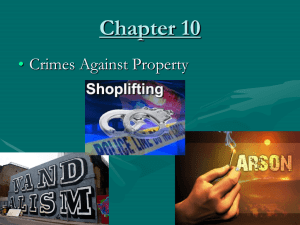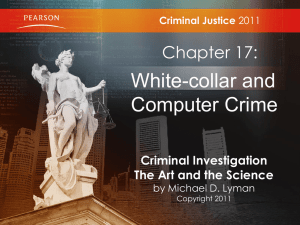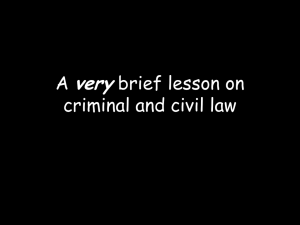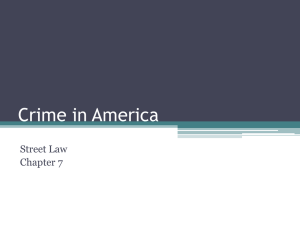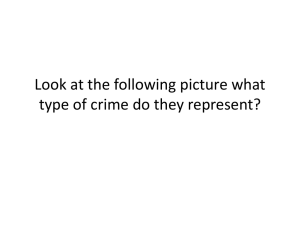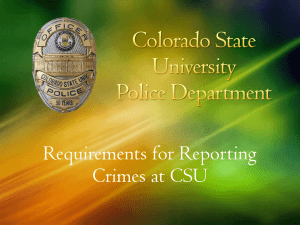Chapter PowerPoint - Capital High School
advertisement
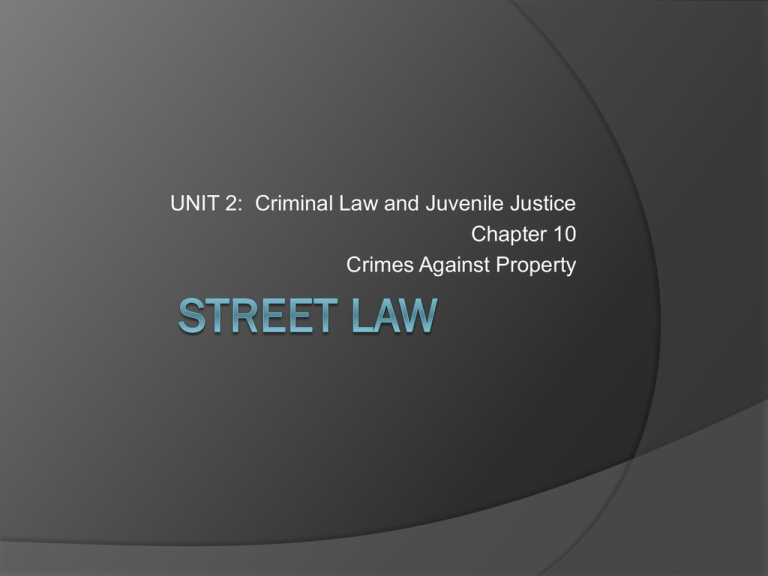
UNIT 2: Criminal Law and Juvenile Justice Chapter 10 Crimes Against Property The category of crimes against property includes two groups crimes in which property is destroyed (such as arson & vandalism) & crimes in which property is stolen or taken against the owner's will (such as robbery & embezzlement) During the late 1990s, there were fewer crimes against property, in part because Americans developed better ways to prevent these crimes These behaviors include ○ Security lighting ○ Home & car alarm systems ○ Steering wheel locks ○ Greater attention to locking doors & windows ○ A tendency to carry less cash due to the greater use of credit cards Arson and vandalism are examples of crimes involving the destruction of property Arson is the intentional & malicious burning of another person's property ○ In most states it is a crime to burn any building or structure, even if the person setting the fire is the owner ○ Burning property with the intent to defraud an insurance co. is a separate crime, regardless of the type of property burned or who owned the property ○ Arson has also been a form of racial violence To help federal prosecutors deal with a rash of racially motivated church arsons, Congress passed the Church Arson Prevention Act of 1996 This act help oversee the investigation & prosecution of arson at places of worship across the U.S.; it also seeks to increase the penalties for such crimes Vandalism is the willful destruction of or damage to another person's property Effects of vandalism include broken windows, graffiti, & damage to cars Costs include repair, cleanup, & replacement It can be a felony or a misdemeanor Juvenile statistics (doesn’t include # of incidents in which an arrest was never made) 12% are female; 88% are male 80% are white; 17% are African American; 1% are Native American; 1% are Asian “Broken Window” Theory If communities don’t react strongly to crimes like vandalism, panhandling, & prostitution, worse crime will follow Suggests that when 1 broken window isn’t fixed, other windows will be broken ○ When there is no response to “low-level crime” by law enforcers, criminals will assume that crime is tolerated in that community & crime will therefore escalate ○ This had led to “zero-tolerance” policies which punishes first time offenders swiftly & significantly ○ People believe that communities are cleaner, residents feel safer, & the general quality of life improves People who disagree with these types of policies believe that police & community leaders should focus their resources on more serious crimes Disproportionate effect on the poor because many instances of vandalism & crime take place in povertystricken areas These are people who are the least able to pay them In some communities, the relationships between residents & police are already strained & are made worse when people feel like they are harassed for minor offenses by police who are “just doing their jobs” There are many other categories of crimes that involve taking property against the will of the owner Larceny is the unlawful taking & carrying away of another person's property with the intent never to return it to the owner ○ Most states identify larceny as either grand or petty Grand larceny—which is a felony—occurs when anything above a certain value is stolen (usually $100) Petty larceny is a misdemeanor that involves the theft of anything of small value (usually < $100) Larceny also includes keeping lost property when a reasonable method exists for finding the owner Ex: finding a wallet that includes a driver’s license You may also be guilty of larceny if you keep property delivered to you by mistake Shoplifting is a form of larceny It is the crime of taking items from a store w/o paying for them or intending to pay for them ○ Some states have a separate crime called concealment (attempted shoplifting) ○ Shoplifting results in huge losses for businesses Costs are passed on to consumers in the form of higher prices Everyone pays for shoplifting Embezzlement is the unlawful taking of property by someone to whom it was entrusted Ex: bank tellers, stockbrokers Some states have merged the crimes of embezzlement, larceny & obtaining property by false pretenses (intentional misstatements of fact into the statutory crime of theft Robbery is the taking of property from a person's immediate possession by using force or threats Robbery involves 2 harms: ○ Theft of property, & ○ Actual or potential physical harm to the victim The difference between robbery & larceny is the use of force Ex: a pickpocket who takes your wallet unnoticed is guilty of the crime of larceny Ex: a mugger who knocks you down & takes your wallet by force is guilty of robbery Robbery is almost always a felony Stricter penalties for armed robberies—thefts committed with a gun or other weapon Extortion, also called blackmail, takes place when one person uses threats to obtain another person's property The threats may include harm to the victim's body, property, reputation, or loved ones Ex: a person who threatens to injure you or your property unless you give him your car is guilty of extortion Burglary is the unlawful entry into any dwelling or structure with the intention to commit a crime (regardless of time of day) Originally defined as breaking & entering the dwelling of another person during the night w/intent to commit a felony Stiffer penalties for burglaries committed at night, of inhabited dwellings, or committed w/weapons Forgery is a crime in which a person falsely makes or alters a writing or document with intent to defraud Ex: signing the name of another person to a check or some other document w/o permission Ex: changing or erasing part of a previously signed document Uttering is offering to someone as genuine a document (such as a check) known to be a fake Identity Theft A serious criminal action that has the potential to affect anyone w/a Social Security # Children are ideal targets – can be used for years w/o detection ○ Generally identity theft is discovered when a person applies for a credit card, driver’s license, or gets a credit report For adults, $ & power often increase the likelihood of victimization because important information about celebrities is generally easier to access Receiving stolen property involves receiving or buying property that you know or have reason to believe is stolen Knowledge that the property is stolen may be implied by the circumstances ○ Ex: buying goods out of the trunk of a car or for a price that is unreasonably low It’s a felony if the value of the property received is > $100 & a misdemeanor if < $100 Unauthorized use of a vehicle If the person only intends to take the vehicle temporarily ○ Includes joyriding If the intent is to take the vehicle permanently, then the crime may be larceny or auto theft (stiffer penalties) Carjacking occurs if a person uses force or intimidation to steal a car from a driver A federal crime & is punishable by a sentence of up to life in prison Anti Car Theft Act (1992) ○ Law covers the use of force or intimidation to steal a car from a driver The Internet has led to an increase in computer crime Any violation of criminal law that involves the use of computer technology to commit the prohibited act ○ Involves traditional crimes that now may be committed through the use of a computer Ex: the use of a computer to make fake identifications or making fraudulent credit card purchases w/someone else’s credit card # that has been intercepted over the Internet ○ It also involves crimes that are relatively new & specific to computers Ex: the intentional spreading of a computer virus or using programs to steal passwords Computer crime is committed for several different reasons Employees who are angry with their company Hackers who gain illegal entry to gov. or corporate computer systems ○ they are relatively harmless & tend to break into sites for fun, for a challenge, or to point out security flaws Crackers (criminal hackers) who seek to make $ from breaking into computers Hackers tend to be middle- or upper-income males who begin their criminal activity in HS & usually stop after college Tend to think of themselves as an elite group of information seekers who are adept at exploring computer systems & networks Have the time & access to computers necessary Do not fear loss of jobs or personal wealth (factors that deter adults) An outlet for social anxiety – fills a social void Share a similar profile to the students responsible for violent school rampages, such as Columbine (1999) Breaking into a corporate or government system to which you don’t have access is a federal crime – regardless of motive (as long as there is a guilty state of mind of intending to break into the site) Computer Fraud & Abuse Act (1986) Provided the government with a specific law to prosecute hackers Electronic Communication & Privacy Act (1986) Offers protection to computer operators The federal gov. & law enforcement officials are required to obtain a search warrant before seizing or reading any electronic mail This doesn’t apply to private employers National Infrastructure Act (1996) Illegal to threaten to cause damage to a computer system unless the owner gives something of value Illegal to intentionally give or receive passwords that would permit unauthorized access to systems Children’s Internet Protection Act (2000) Limits access to obscene images, movies, & sound at libraries USA Patriot Act (2001) Gives gov. & law enforcement officials broader powers to access a suspect’s Internet communications than has typically been permitted by the 4th Amendment Most computer crimes probably go unreported Companies are reluctant to publicize their vulnerability to computer criminals or customers Many are discouraged by the time & resources needed to prosecute individuals Cyberstalking & Internet Pornography Young people are particularly vulnerable Challenge is to find ways to protect children from people who abuse the Internet w/o overly restricting access & discussion groups for the majority of adults who use the Internet for lawful, constitutionally protected uses Child pornography & minors’ access to adult pornography through use of the Internet are forms of computer crime Actions aimed at effectively curbing these illegal uses of computers often threaten to infringe upon important First Amendment rights concerning freedom of speech, expression, & association, as well as access to information Child pornography is always illegal in the US Use of the Internet to promote such images is also illegal The Internet is an international tool – access is available to child pornography that is shot in places where it is not illegal The US has no jurisdiction over such web sites The First Amendment doesn’t protect the right of any minor to access pornography Laws that prevent sales & rentals of such materials to minors have been upheld as constitutional Minors are generally not viewed as having the full range of rights as adults Infringements on constitutional rights are acceptable where there is an important gov. interest ○ The gov. has an interest in restricting minor’s access to pornography ○ It is not difficult to pass & enforce laws that prevent businesses from selling porn to minors; it is more difficult to limit access to this information on the Internet The government also watches bulletin boards Exchange of computer files & messages Illegal download of software programs Illegally copying software Violates federal copyright laws Subject to a possible jail term & a fine of up to $250,000
